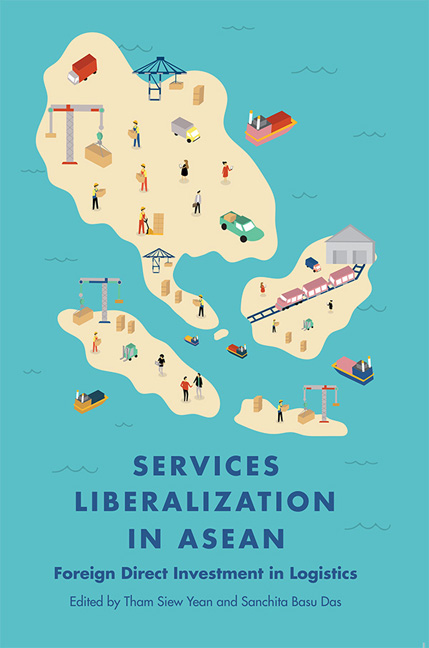Book contents
- Frontmatter
- CONTENTS
- List of Tables
- List of Figures
- Foreword
- Preface
- Acknowledgements
- Abbreviations
- About the Contributors
- 1 Introduction
- 2 Reforming Indonesia's Logistics Sector
- 3 FDI Liberalization in Malaysia's Logistics Services
- 4 Logistics Services Liberalization in the Philippines
- 5 Services Sector Liberalization in Singapore: Case of the Logistics Sector
- 6 Logistics Services Liberalization in Thailand
- 7 Services Liberalization in Vietnam: The Case of FDI in Logistics Sector
- 8 Services Liberalization: Case of Logistics in Brunei
- 9 FDI, Services Liberalization and Logistics Development in Cambodia
- 10 Services Liberalization in Lao PDR: FDI in Logistics Sector of a Land-linked Country
- 11 Facilitating FDI for the Logistics Sector in Myanmar: Agency, Incentives, and Institutions
- Index
Foreword
Published online by Cambridge University Press: 04 July 2018
- Frontmatter
- CONTENTS
- List of Tables
- List of Figures
- Foreword
- Preface
- Acknowledgements
- Abbreviations
- About the Contributors
- 1 Introduction
- 2 Reforming Indonesia's Logistics Sector
- 3 FDI Liberalization in Malaysia's Logistics Services
- 4 Logistics Services Liberalization in the Philippines
- 5 Services Sector Liberalization in Singapore: Case of the Logistics Sector
- 6 Logistics Services Liberalization in Thailand
- 7 Services Liberalization in Vietnam: The Case of FDI in Logistics Sector
- 8 Services Liberalization: Case of Logistics in Brunei
- 9 FDI, Services Liberalization and Logistics Development in Cambodia
- 10 Services Liberalization in Lao PDR: FDI in Logistics Sector of a Land-linked Country
- 11 Facilitating FDI for the Logistics Sector in Myanmar: Agency, Incentives, and Institutions
- Index
Summary
ASEAN turns fifty this year. And there is cause for celebration. For a group of countries that are so economically, politically and culturally varied, it has achieved much over the five decades. To appreciate the strides made by this regional grouping one has to explore ASEAN's economic journey from modest goals of a preferential trade agreement (PTA) in the 1970s through the establishment of the ASEAN Free Trade Area (AFTA) in the 1990s, the AEC Blueprint 2015 (AEC 2015) and AEC Blueprint 2025 (AEC 2025).
The ASEAN story reflects the grouping's step-by-step confidence building approach towards integration. This served the members well, allowing for domestic adjustments even as it deepened its regional commitments, moving from voluntary liberalization under the PTA, through the rules-based ASEAN Trade in Goods Agreement (ATIGA) and services liberalization under the ASEAN Framework Agreement on Services (AFAS), and laying the foundation for an integrated investment region through the ASEAN Comprehensive Investment Agreement (ACIA). The latter three agreements are core to both the AEC 2015 and AEC 2025 as the region looks to deepening economic integration not just among the ASEAN Member States (AMS) but also with its Dialogue Partners.
ASEAN has been successful in the removal of tariffs for intra-ASEAN trade in goods; done significant work on services liberalization; and has managed some measure of streamlining of investment rules. Much work has also been done on Mutual Recognition Agreements and Standards and Conformance.
Even as ASEAN revels in its achievement, much more needs to be done. Key to ASEAN economic integration is trade facilitation. Meaningful market access for both goods and services requires that ASEAN move forward with work on Non-Tariff Measures, domestic regulations as well as continued infrastructure and human capital development. These measures are outlined in the AEC Blueprint 2025, which has the following features: (i) A Highly Integrated and Cohesive Economy; (ii) A Competitive, Innovative, and Dynamic ASEAN; (iii) An ASEAN with Enhanced Connectivity and Deeper Sectoral Cooperation; (iv) A Resilient, Inclusive, People-Oriented, and People-Centered ASEAN; and (v) A Global ASEAN.
- Type
- Chapter
- Information
- Services Liberalization in ASEANForeign Direct Investment in Logistics, pp. xiii - xvPublisher: ISEAS–Yusof Ishak InstitutePrint publication year: 2017



